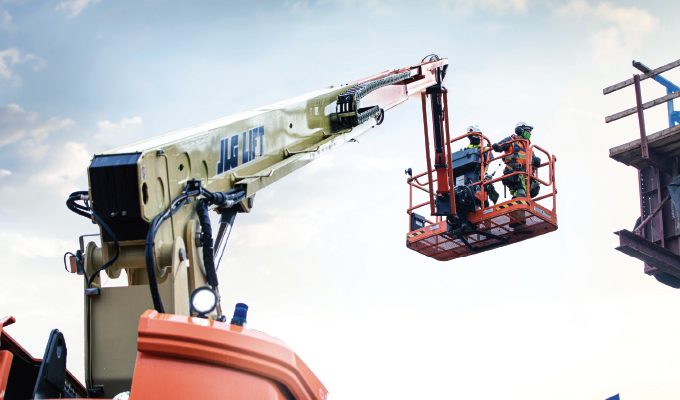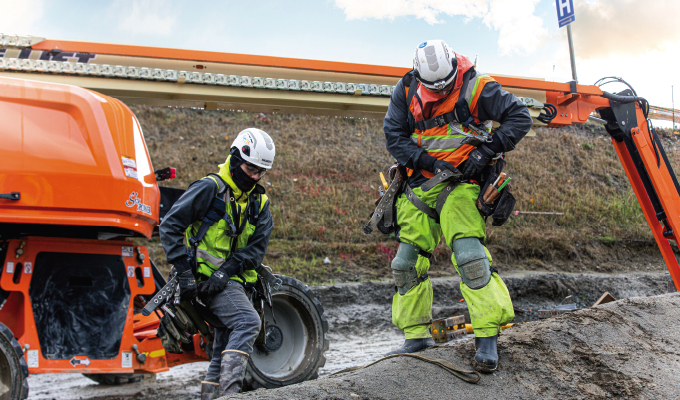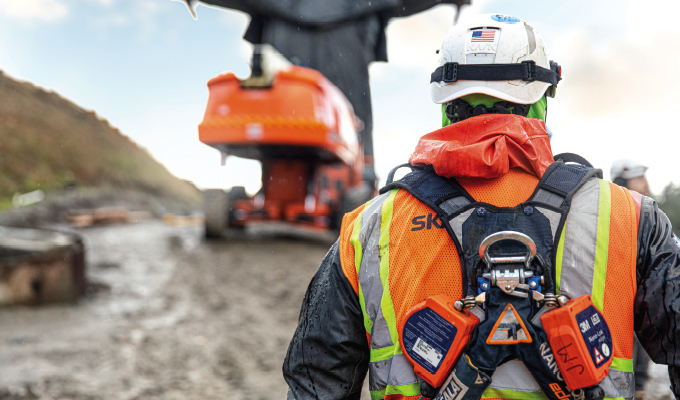Although the benefits of safe work practices apply to all types of equipment, it is especially true for equipment like mobile elevating work platforms (MEWPs), formerly known as aerial work platforms (AWPs). These machines are designed to put people up in the air—even if it’s just a few feet off the ground—to safely complete work at height.
Access equipment manufacturers receive many inquiries each year regarding the use of fall protection equipment for MEWPs, including boom lifts, scissor lifts, and low-level access equipment, such as vertical mast lifts. That’s because construction site tasks performed 6 feet or more off the ground are subject to OSHA’s fall protection regulations.
Most OEMs, including JLG, require equipment owners, users, operators, lessors, and lessees to be in compliance with all applicable standards and regulations (including employer, local, state, and national) pertaining to the utilization of MEWPs. Below is guidance on what fall protection is required when operating different types of MEWPs.

BOOM LIFTS
For fall protection on boom lifts, which includes (but is not limited to) articulating, telescopic, crawler, and towable models, the ANSI Standard for Boom-Supported Elevating Work Platforms (A92.5) and the Canadian Standard for Boom-Supported Elevating Work Platforms (CSA B354.4) require that all personnel in the platform wear fall protection devices at all times.
In support of these standards, in the United States, OSHA’s fall protection rule requires the use of a full body harness for fall arrest in place of a body belt when working from an aerial work platform. The full body harness needs to be attached, via a lanyard, to a lanyard anchorage point.
To be in compliance with these standards and regulations, most MEWP OEMs, including JLG, manufacture their boom lift models with lanyard anchorage points.
SCISSOR LIFTS, VERTICAL MAST LIFTS
Currently, there are no current requirements by ANSI, CSA, or OSHA requiring personnel to wear a fall protection device on scissor lifts or vertical mast lifts (machines covered under the ANSI A92.6 and A92.3 and CSA standards B354.2 and B354.1).
Although not required, many MEWP OEMs, including JLG, recommend that a full body harness be used with a lanyard attached to an authorized lanyard anchorage point when operating scissor lifts or vertical mast products that do not have a 30-inch maximum lanyard length limit. Many MEWP models are similar, but not the same. This means operators may have to utilize different fall protection equipment, depending on how the machines are designed. For example, machines with a 30-inch maximum lanyard length limit have a decal located next to the lanyard anchorage point indicating this maximum length. A fall restraint system must be utilized where fall protection equipment is to be used on machines with a 30-inch maximum lanyard length limit.
It is important to note here that some manufacturers, including JLG, do not authorize the use of fall arrest systems on their equipment.
SAFETY FIRST
Prioritizing safety, many MEWP OEMs, including JLG, presently manufacture new scissor and vertical mast lifts with lanyard anchorage points as standard equipment. In some instances, on certain older models that were not originally equipped with lanyard anchorage points, an authorized equipment distributor can install lanyard anchorage points, per the OEM’s specifications, for the respective product, and these are then considered a means of fall arrest for a fall protection system. If an older MEWP model cannot be updated to be equipped with authorized lanyard anchorage points, the user may attach to the mid-rail section of the main platform rail.
LANYARD ANCHORAGE POINTS
Each authorized lanyard anchorage point is designed specifically to be utilized by one person only. There must be an authorized lanyard anchorage point for each additional person(s) in the platform.
Transferring to a structure from the MEWP while elevated. Because MEWPs are designed to lift operators, tools, supplies and materials to access overhead jobsites or work at height, in the course of this type of work, it is sometimes necessary for MEWP operators to transfer from the equipment platform to an adjacent structure, in order to complete a specific task, while the machine is elevated.
While there is no specific regulation regarding transfers, OSHA has provided guidelines to OEMs, including JLG, for transferring to a structure from a MEWP platform while elevated: “When transfer is necessary … 100 percent tie-off is required in this situation utilizing two lanyards. One lanyard must be attached to the platform with the second lanyard attached to the structure. The lanyard connected to the platform must not be disconnected until such time as the transfer to the structure is safe and complete.”

CLOSING THOUGHT
Before operating any make or model of MEWP, equipment owners and users should always read and understand the machine’s Operation & Safety manual. This manual will outline the necessary precautions that operators need to follow for proper and safe machine usage, including the appropriate safety, training, application, inspection, and operation of the MEWP.
A copy of the machine’s Operation and Safety Manual, AEM Safety Manual (ANSI markets only) and ANSI Manual of Responsibilities (ANSI market MEWPs only) should be enclosed in the weather-resistant storage container of the MEWP. If these manuals are not in the MEWP, please contact the MEWP’s original equipment manufacturer for a copy of the machine’s Operation and Safety Manual and the American National Standards Institute (ANSI) for a copy of the Safety Manual and Manual of Responsibilities.
About the Author:
Jennifer Stiansen is director of marketing with JLG. For more, visit www.jlg.com.
Modern Contractor Solutions, February 2022
Did you enjoy this article?
Subscribe to the FREE Digital Edition of Modern Contractor Solutions magazine.



